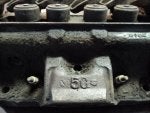Everybody seems to have different opinions when it come to cams. You didn't mention what the motor is going into. If it's an auto tranny car, the cheapest decent cam would be the Summit 2801. But if you use this cam, you'll have to use new springs, cause it has more lift than a stock cam. With stock springs, a duplicate of the 068 Pontiac cam is about the biggest thing you can get by with.
Now, if the car is a 4-speed sick, the Summit 2802 will work (with the appropriate springs). The biggest thing I would consider is a RA4 duplicate, such as the Melling SPC-8, and then only with Rhoads RL-9518 lifters to smooth out the low end a bit.
While the motor is out, it would be a good idea to have some taken off the heads to increase compression. If you take .050 off the surface, also have them take .050 off the intake port side so that the intake manifold will still line up correctly. I don't know what your budget is for this project, but one thing leads to another. While they're doing the heads, it's good insurance to buy new stainless steel valves to replace the almost 40 year old ones.
And if you do this, since you'll need new head gaskets, you can buy the .027 thick Cometics, with a 4.160 bore and increase the comp a bit more. All this extra comp will help to "add a bit more power".
Also be sure to use polylocks, and adjust the rockers to no more than 1/4 to 1/2 turn below 0 lash. Some roller tip rockers, like the PRW's will help prevent wear on the valve tips. Well, I won't take this any farther. But you can see how one thing leads to another, and can quickly blow your budget.
If you wanna price any of these items, from somewhere other than Summit, I'll help you find the best prices.











